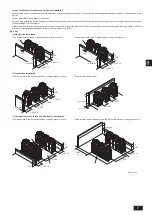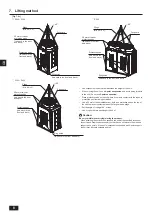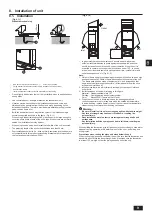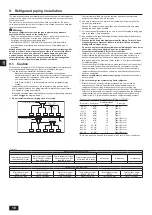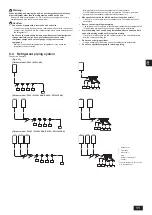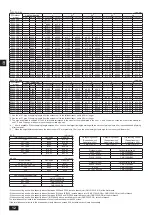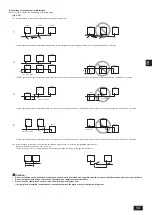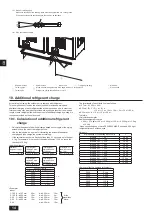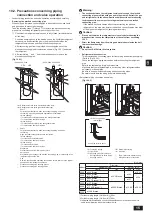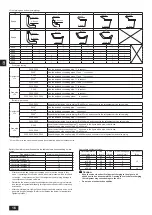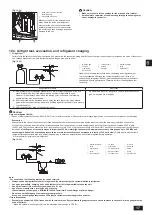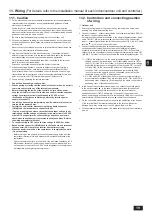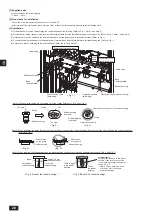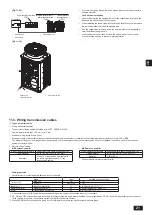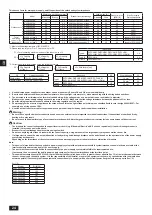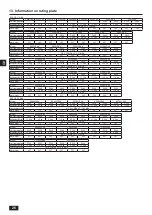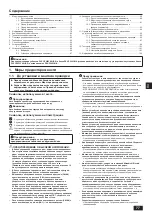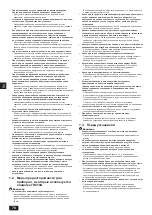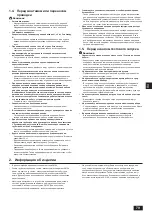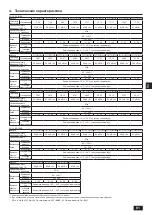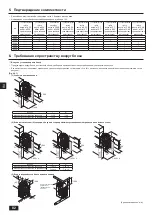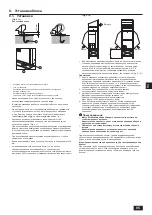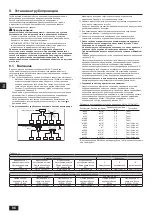
21
GB
11.3. Wiring transmission cables
1
Types of control cables
1. Wiring transmission cables
•
Types of transmission cables: Shielding wire CVVS, CPEVS or MVVS
•
Cable diameter: More than 1.25 mm
2
or ø1.2 mm
•
Maximum wiring length: Within 200 m
•
Maximum length of transmission lines for centralized control and indoor/outdoor transmission lines (Maximum length via outdoor units): 500 m MAX
The maximum length of the wiring between power supply unit for transmission lines (on the transmission lines for centralized control) and each outdoor unit and
system controller is 200 m.
2. Remote control cables
• ME Remote Controller
Kind of remote control cable
Sheathed 2-core cable (unshielded) CVV
Cable diameter
0.3 to 1.25 mm
2
(0.75 to 1.25 mm
2
)*
Remarks
When 10 m is exceeded, use cable with
the same specifications as 1. Wiring
transmission cables.
• MA Remote Controller
Kind of remote control cable
Sheathed 2-core cable (unshielded) CVV
Cable diameter
0.3 to 1.25 mm
2
(0.75 to 1.25 mm
2
)*
Remarks
Within 200 m
* Connected with simple remote controller.
2
Wiring examples
•
Controller name, symbol and allowable number of controllers.
Name
Code
Possible unit connections
Outdoor unit
Main unit
OC
– (*2)
Sub unit
OS1, OS2
– (*2)
Indoor unit
Indoor unit controller
IC
1 to 26 units per 1 OC (*1)
Remote controller
Remote controller (*1)
RC
2 units maximum per group (*3)
Other
Transmission booster unit
RP
0 to 1 unit per 1 OC (*1)
*1 A transmission booster (RP) may be required depending on the number of connected indoor unit controllers.
*2
OC, OS1 and OS2 of the outdoor units in the same refrigerant system are automatically identified. They are identified as OC, OS1 and OS2 in descending order of capacity.
(If the capacity is the same, they will be in ascending order of their address number.)
*3 When a PAR-31MAA is connected to a group, no other MA remote controllers can be connected to the same group.
[Fig. 11.2.1]
C
L1 L2 L3 N
A
B
A
Power source
B
Transmission line
C
Earth screw
[Fig. 11.2.2]
A
B
C
A
Cable strap
B
Power source line
C
Transmission line
• If there are any gaps around the wires, please be sure to fill these in with a
suitable material.
2
Conduit tube installation
•
Open by hammering the knockout holes for the conduit tube located on the
base and the bottom part of the front panel.
•
When installing the conduit tube directly through the knockout holes, remove
the burr and protect the tube with masking tape.
•
Use the conduit tube to narrow down the opening if there is a possibility of
small animals entering the unit.
•
When taking the conduit tube out from the bottom part of the unit, caulk
around the tube opening to prevent water penetration.
Control box
Power supply terminal block
(TB1)
Terminal block for indoor –
outdoor transmission line
(TB3)
Terminal block for
centralized control
(TB7)

